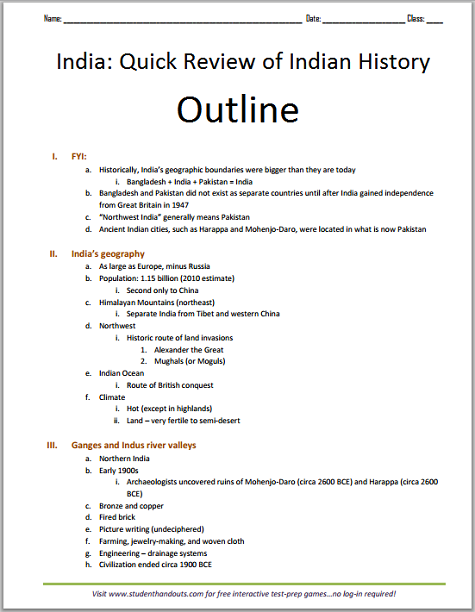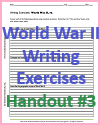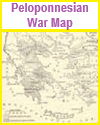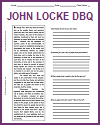| Overview History of India Outline |
|---|
| www.studenthandouts.com > World History > Ancient India > Ancient India Outlines & PowerPoints |
 |
 |
|---|
| Click here to print (PDF file). For a PowerPoint version of this outline, click here.
I. FYI a. Historically, India's geographic boundaries were bigger than they are today i. Bangladesh + India + Pakistan = India b. Bangladesh and Pakistan did not exist as separate countries until after India gained independence from Great Britain in 1947 c. "Northwest India" generally means Pakistan d. Ancient Indian cities, such as Harappa and Mohenjo-Daro, were located in what is now Pakistan II. India's geography a. As large as Europe, minus Russia b. Population: 1.15 billion (2010 estimate) i. Second only to China (until recently; back-and-forth with China for most populous country) c. Himalayan Mountains (northeast) i. Separate India from Tibet and western China d. Northwest i. Historic route of land invasions 1. Alexander the Great 2. Mughals (or Moguls) e. Indian Ocean i. Route of British conquest f. Climate i. Hot (except in highlands) ii. Land—very fertile to semi-desert III. Ganges and Indus river valleys a. Northern India b. Early 1900s i. Archaeologists uncovered ruins of Mohenjo-Daro (circa 2600 B.C.E.) and Harappa (circa 2600 B.C.E.) c. Bronze and copper d. Fired brick e. Picture writing (undeciphered) f. Farming, jewelry-making, and woven cloth g. Engineering—drainage systems h. Civilization ended circa 1900 B.C.E. IV. Aryan migration (circa 1700-1300 B.C.E.) a. Invaders came from Europe i. Traced through Indo-European language roots b. Ruled India for hundreds of years c. Set up small kingdoms ruled by rajahs d. Conquered native Dravidians e. Created modern Hinduism from Dravidian religious traditions and their own ideas f. Established India's caste system V. Vedic Age (circa 1500-500 B.C.E.) a. Vedas written in Sanskrit (India's literary language) b. Mahabharata c. Ramayana VI. Alexander the Great (ruled India circa 327-326 B.C.E.) a. Macedonian (Greek) who led conquering forces across northern India b. Ruled briefly c. Greeks expelled from most of India after Alexander's death d. Continued contact with Alexandrian successor state, the Seleucid empire, with the west VII. Maurya Empire (322-185 B.C.E.) a. Dynasty begun by Chandragupta Maurya b. Asoka (grandson), 273-232 B.C.E. i. Ruled all of India ii. Converted to Buddhism iii. Religious tolerance, generosity, wisdom, and kindness iv. Spread Buddhism—Burma, Ceylon, Siam, Tibet v. War and disunity after his death VIII. Gupta dynasty (320-467 C.E.) a. Northern India reunited b. Trade i. With west ii. Burma, Indochina, Java, Sumatra iii. Buddhism and Hinduism spread out 1. Cultural diffusion IX. Mughal empire (1526-1858) a. 12th century—Muslim invasion b. 1500—Central Asians, led by Mughals (Moguls), established a kingdom in northern India c. Akbar (1556-1605) i. Conquest of central India ii. Efficient and strong government iii. Religious tolerance iv. Business and commerce encouraged d. Architecture i. Forts, mosques, palaces, tombs 1. Taj Mahal in Agra, India—tomb for a Mughal emperor's favorite wife X. End of the Mughal empire a. 17th century – empire crumbled i. Fighting between smaller kingdoms ii. English, French, and Portuguese traders gained influence b. 1763—Seven Years' War i. Fight in North America known as the French and Indian War ii. English (British East India Company) won control of India from the French iii. Taken over by the British government under Queen Victoria (British Raj, 1858-1947) 1. Independent after World War II (1947) XI. Hinduism a. Escape sins of life by attaining purity and perfection of the soul b. Caste system i. Process starts in lowest caste (Untouchables) ii. Soul reincarnated in person of higher caste iii. Must carry out duties of the caste iv. Repeated rebirths v. Soul ultimately becomes perfect and merges with the soul of Brahma (principal god) XII. Castes a. Original castes i. Brahmin (priests) ii. Warriors iii. Farmers and traders iv. Sudra (servants) b. Eventually divided by occupation into thousands of castes i. Lowest—the Untouchables 1. Strict purification rituals if others contact them 2. Today—legal protections under Indian law, but prejudice still exists XIII. Hinduism (continued) a. All life is sacred i. Animals respected ii. Cow is sacred iii. Most Hindus are vegetarians b. Basic beliefs i. World is evil ii. Reincarnation after death (animal or human) iii. Soul purified by completion of caste duties iv. Reverence for animals v. Escape world's evils through prayer XIV. Buddhism a. Founded by Gautama (563-483 B.C.E.) i. Age 30—gave up position and wealth to study the right way to live ii. Called Buddha ("the enlightened one") b. Life is evil and suffering i. Can be avoided by good desires c. Eightfold Path i. Do not gossip, have impure thoughts, hate, lie, or steal d. Rare in India today, but spread through eastern Asia XV. Culture a. Kalidasa (6th century C.E.) i. Playwright and poet ii. Fairy stories and animal fables b. Art and architecture i. Temples covered with designs and figures XVI. Science and math a. Mathematics i. Zero ii. Decimal point iii. Minus sign iv. "Arabic" numerals (Europe got them from Arab traders, who got them from India) b. Gupta period (320-467 C.E.) i. Leaders in dyeing, tanning leather, soap and glass making c. Textiles i. Cotton, cashmere, calico, chintz – all originally Indian terms XVII. Review questions a. After 1947, India split into what three separate countries? b. What two ancient Indus River Valley civilizations were discovered by archaeologists in the early 1900s? c. The Vedas were written in what language? d. What religion was practiced by the Mughal emperors? e. Describe India’s caste system. f. What is the origin of the term "Arabic numerals"? |
|---|
| Ancient India Books and Films | Ancient India Outlines and PowerPoints |
| Ancient India Maps and Pictures | Ancient India Study Games |
| Ancient India Miscellany | Ancient India Worksheets |
| www.studenthandouts.com > World History > Ancient India > Ancient India Outlines & PowerPoints |









